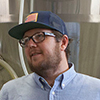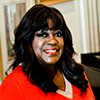



Barley, 33, discovered his love for beer while visiting Belgium in college, but it remained merely an avocation till almost ten years later, when he cofounded Solemn Oath Brewery in Naperville. Today the brewery is in the middle an expansion that could nearly double its output, and Barley serves as president of the Illinois Craft Brewers Guild, which advocates for the state's brewers in Springfield and beyond.
Interview by Philip Montoro
Photos by John Sturdy and Kevin Kujawa

I never home brewed. The first time I ever made beer was the first time we turned our system on here at Solemn Oath. My parents lived in Brussels, Belgium, for a long time. So when I was in college, I would go visit them on every break. We’d go to all the different breweries and bars. I drank Harp before that, but experiencing Belgian beer in Belgium opened my eyes to what beer could be.
I fell in love with the culture of it. I came back and started exploring. My professional career was sports-related communications prior to this. I worked for a pro soccer team; I worked for a now defunct weekly paper, Chicago Sports Review. I was director of communications for a youth-focused nonprofit. We ran golf tournaments for kids—the Illinois Junior Golf Association.
In August of 2010, I was visiting my brother [Joe], who was living in Carlsbad, and he threw a party where everybody had to bring a different beer. And we went to like ten or 12 breweries that weekend. On the flight home I really started getting serious about it. I made some connections in the industry, designed a business plan, and in January 2011 we were fully funded and rocking. It’s just my family and a couple of buddies that have a piece of it.

I started building a team immediately. I found Tim Marshall, our head brewer. I needed a guy who could take the reins on the beer and I could serve as his number two. We’ve got four full-time and a couple part-time guys.
I want talented and smart people that disagree with me and that argue with me and can push this—the business side of it particularly—in a cool direction. [Operations manager] Erin [Lowder] was working at Topshop and was trained in fashion. [Brewer] Paul [Schneider] is a Yale-educated high school teacher. Having brewing experience or working within the industry was not a huge priority for me. The only resumé I’ve seen of anybody that’s full-time here is our head brewer.
In front of our brew house there’s a Latin phrase, Aut viam inveniam aut faciam, painted on the floor, which is “I shall either find a way or make one.” That’s the first thing we did before we even put the system in—it served as our cornerstone.

Our tap room is packed every night. My favorite part is that it’s, like, a grandma sitting next to a tattooed hipster guy standing next to a suburban dad. Beer pulls people in, and it’s a kind of a magnetic thing.

We’re making beers that we want to drink, and we like to drink a lot of different stuff. Tim Marshall’s a brilliant dude. We don’t want to say, “Hey, these are the six core beers that we make.” We know how to make a lot of different IPAs. We know how to make a lot of different Belgian pales. Rather than say, “This is our IPA, this is our Belgian pale,” we want to work with the people that follow us in the tap room, our distributors, and our own personal tastes to figure out what we should be making on a year-round basis.
We’re in the midst of a 95 percent expansion. We’re introducing cans. We were draft-only for 18 months—to get our sea legs. In December [2013] we introduced bottles. And as soon as we introduced bombers, we started to try to have another product. So we went with cans. We’ve got a new brew house that’s gonna give us a lot more potential capacity. It’s a Metalcraft—they’re out of Oregon—a 30-barrel, three-vessel steam-fired system. We’ll be able to make a lot more beer. Right now we have eight 30-barrel fermenters and one 15. We’re adding four 60-barrel fermenters.

I took over [as president of the Illinois Craft Brewers Guild] this summer. I believe it was August. And Pete Crowley of Haymarket had served in that capacity—anything before Pete was like six dudes getting together at a bar. Now it’s much more organized, and we have staff and four major events. We serve the needs of this community of brewers. A lot of that’s legislative; a lot of that’s helping spread the word for smaller breweries through our events. Preaching the importance of Illinois beer and growing it.
We have such a strong community. This is what I think of when I think of Illinois beer—east coast, for example, they don’t have the tight-knit community that we do. On our opening night, we were understaffed, and Jim Ebel of Two Brothers was behind our bar pouring beers. That sort of propping each other up doesn’t happen all over the country.

Here in Chicago, we’re at 10 percent market share for craft. We attend some stuff in southern California—it was like looking into the future, because it’s a further developed market than ours. You look in those communities, and it’s 40, 50 percent. So if you take all the brewers that exist right now in Chicago, everybody here would be able to grow by 400 percent just to catch up with other parts of the country. Oregon’s like that—50 percent draft, maybe even higher. There’s a lot of room. These large craft brewers that are making these huge expansion plans as well, like Lagunitas—I mean, they built the biggest craft brewery in the country on the south side of Chicago—they’re going to build bridges all over the place. You’re going to see Lagunitas IPA in VFWs. As they break those barriers, those six-draft-line neighborhood bars that have only had Coors and Miller get a Lagunitas handle in there, and they’ll probably have one or two other local beers.
What you’re going to see is some consolidation. Green Flash just made a move—they acquired Alpine, like a 3,000-barrel brewery. The bottleneck with all these brewers growing is, it takes six months to eight months to physically expand, to build a larger facility—what Gabriel [Magliaro] and Half Acre are doing right now. Or these larger operations can buy small brands. They can keep the identity, they can keep the culture, while giving them the opportunity to expand. Good for them.

I was watching a talk by Kim Jordan of New Belgium at CBC [Craft Brewers Conference] this year, and she was like, “Don’t start a brewery, don’t build your brewery, don’t grow your brewery until you know what your exit strategy is.” If you want to sell your brewery to AB [InBev], you should build your brewery to be sold to AB. Those guys [New Belgium] are the strongest community probably in all of craft, and everybody gets bikes—it’s like its own little village out there. They built that company to sell it to their employees. So that’s exactly what they did.
Beer civilizes, as they say. It’s considered one of the pillars of civilization. When we stopped being nomads, we sat down and started cultivating, and started making beer.
It’s jazz in the 40s right now. This is the next great American export, in my opinion. There’s a lot of passion and culture behind it. And that’s something that exists in a bottle. That’s a story that Solemn Oath, for example, can tell through our imagery and through our snark on our website. Within Solemn Oath we don’t set one direction. It’s going to continue to take on a life of its own. We find a lot of things interesting; we find a lot of things funny. At the end of the day, it’s still just beer. So why are we not going to have fun with it?






















